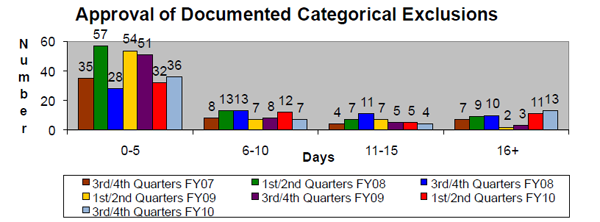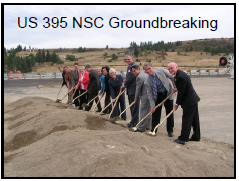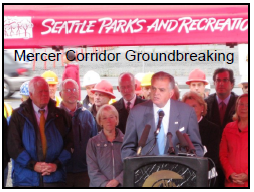U.S. Department of Transportation
Federal Highway Administration
1200 New Jersey Avenue, SE
Washington, DC 20590
202-366-4000
Washington Division
The Federal Highway Administration (FHWA) Washington Division has developed the following Project Delivery Report which highlights some of the broad array of activities / initiatives / approvals we perform to assist the Washington State Department of Transportation (WSDOT) and local agencies in delivering projects.
The EDC Innovation Initiative Summit for the Northwest was held in Vancouver, WA November 30 and December 1, 2010. The Summit was attended by representatives from Federal, State and Local governments, industry associations, MPOs, Tribes, and Tribal Technical Assistance Program offices from the Northwest. The goal of the Summit was to explain the 8 (eight) initiatives associated with shortening project delivery, 5 (five) initiatives related to accelerating technology/innovation, and the 2 (two) initiatives intended to accelerate project delivery, determine the status of activities in each State related to the initiatives, begin to identify which initiatives the State would attempt to deploy, identify barriers to deploying initiatives, identify other stakeholders that should be invited to participate in the EDC deployment effort, begin to identify teams that would lead deployment efforts.
The Summit opening plenary session included a videotaped greeting and EDC Vision statement by Administrator Mendez. Deputy Administrator Greg Nadeau presented the EDC Model and explained the anticipated Summit Outcomes. John Horsley, AASHTO Executive Director, discussed the benefits of deploying the EDC initiatives to the States and local agencies. After the initial plenary session there were breakout sessions for each of the initiatives in which the technical experts from FHWA explained the initiative in detail. There was also discussion during these sessions about barriers to implementing the initiatives.
The States had a second chance to meet with, discuss, and ask questions about the 5 technology/innovation initiatives. At the end of the Summit, each State was asked to meet and discuss each of the initiatives, determine which initiatives they are already doing, which ones they would not attempt to deploy, begin a discussion about what other stakeholders need to be involved, and what needs to be done to further advance initiatives that need more effort. Participants were given an opportunity to identify initiatives that were missing from EDC.
The Washington state caucus concluded that we have deployed the majority of the initiatives; however, there are several that need more effort. There were several suggestions for additional initiatives, most notably investigating flexibilities for advanced acquisition of right-of-way parcels.
 AMERICAN RECOVERY AND REINVESTMENT ACT (ARRA) AND TIGER ACTIVITIES
AMERICAN RECOVERY AND REINVESTMENT ACT (ARRA) AND TIGER ACTIVITIES
The US 395 North Spokane Corridor (NSC) project in Spokane County was one of two projects In Washington state to receive a TIGER grant. This project will build 3.7 miles of southbound US 395 from Francis Avenue to Farwell Road to complement the existing northbound lanes. The full project, once completed, will provide a necessary north/south link between I-90 and existing US 2 and US 395 to reduce congestion, increase mobility and enhance safety.
The NSC has a long history. Since the start of NEPA in 1988, a Record of Decision (ROD) was completed in November 1997 and a Supplemental ROD in November 2000. This TIGER project had a re-evaluation approved in February 2009 and was submitted for the grant in early September 2009. In late September 2009 a new guidance concerning Mobile Source Air Toxics (MSAT) was published. This guidance was not followed which resulted in a lawsuit. Prior to this project being authorized for construction, FHWA staff from HQ and Resource Center, in consultation with Washington State DOT and Spokane Regional Transportation Council and other partners, conducted the necessary studies, which confirmed there were no significant impacts to the corridor. Although this analysis was not done previously, the outcome did not change and the lawsuit was settled. The project is currently under construction.

This chart shows the timeliness of approval of documented categorical exclusions (DCEs) semi-annually from FY2007 to FY2010.
As the chart depicts, we are approving the vast majority of DCEs within the first 10 days of receipt.
WSDOT turned on the state's first Active Traffic Management (AcTM) system, or Smarter Highways, on northbound I-5 near Boeing Field on August 10, 2010. Washington is the second state, after Minnesota, to deploy an AcTM system in the U.S. AcTM has proven effective in reducing crashes and congestion in multiple countries in Europe over the past decade. The initial seed for AcTM in Washington state was planted during the 2006 Congestion Management International Scan Tour, sponsored by FHWA, of which representatives from WSDOT and PSRC attended. FHWA also funded and participated in the development of the Washington AcTM Feasibility Study in 2007. Since the announcement of the Urban Partnership Agreement (UPA) award to WSDOT, Puget Sound Regional Council and King County in 2007, which includes full funding for the AcTM systems on SR 520 and I-90 over Lake Washington, the Washington Division has worked closely with WSDOT on the development of these AcTM projects. The Washington Division conducted inspections of the AcTM construction on I-5, sign testing facility, and software development in the Traffic Management Center and also played a key coordination role in FHWA's approval of the Manual on Uniform Traffic Control Devices (MUTCD) experimental use request for AcTM signing. Overall, FHWA, and in particular the Washington Division, is proud to be a partner with WSDOT in the planning and deployment of AcTM in Washington and looks forward to sharing these projects as innovative best practices for other states to follow.

This chart shows the timeliness of approval for right-of-way (R/W) Certifications 3 (Cert. 3s)
Certifications that took longer than 10 days required negotiations that took additional time to finalize.
| * | Approval of certifications 1 and 2 have been delegated to WSDOT. |
| ** | In order to authorize the advertisement of a project for construction, the State must certify the R/W has been cleared, per 23 CFR 635.309. |
| *** | Certification 3s are to be used only in very unusual circumstances. |
| Number of Days | 1999 | 2000 | 2001 | 2002 | 2003 | 2004 | 2005 | 2006 | 2007 | 2008 | 2009 | 2010 |
|---|---|---|---|---|---|---|---|---|---|---|---|---|
| 0 to 5 Days | 208 | 780 | 858 | 724 | 1327 | 1463 | 1456 | 943 | 1451 | 1645 | 2261 | 1936 |
| 6 to 10 Days | 24 | 241 | 307 | 121 | 90 | 101 | 103 | 68 | 175 | 128 | 113 | 131 |
| 11 to 15 Days | 12 | 77 | 109 | 39 | 10 | 22 | 24 | 13 | 37 | 12 | 7 | 18 |
| 16 to 20 Days | 9 | 29 | 34 | 21 | 5 | 3 | 8 | 1 | 18 | 5 | 1 | 3 |
| 20 + Days | 31 | 152 | 68 | 98 | 52 | 15 | 17 | 8 | 16 | 13 | 5 | 1 |
| Totals | 284 | 1279 | 1376 | 1003 | 1484 | 1604 | 1608 | 1033 | 1697 | 1803 | 2387 | 2089 |
This table reflects the number of authorizations / modifications approved within certain timeframes since 1999.
(Note: the FY begins on October 1 and ends on September 30 of the following year.)

This chart shows the timeliness of approval for emergency relief (ER) damage inspection reports. Our goal is to approve 90% of these reports within 10 days of receipt.

On October 20, 2010, the USDOT awarded $45 million to Washington State for the following three TIGER II projects: 1) South Park Bridge in King County ($34 Million); 2) East Foster Wells Road Extension in Franklin County ($1.01 Million); and 3) West Vancouver Freight Access Project in Clark County ($10 Million). Prior to these TIGER II projects, on February 17, 2010, Washington state was the recipient of two TIGER grants: 1) US 395 North Spokane Corridor (NSC) ($35 Million) in Spokane County and 2) Seattle's Mercer Corridor ($30 Million). |

Both projects are designed to enhance safety, reduce congestion and revitalize economically depressed areas. These projects are currently under construction and held groundbreaking ceremonies in late October that Ray LaHood, Secretary of Transportation attended. The Washington Division played a key role in getting the project agreements and performance measures drafted and approved. The NSC was the first TIGER project in the country to go through this process and the Mercer was the third. |
The chart shows the timeliness of approval of project authorization/ modifications for the Recovery Act projects.
For FY2010 we approved 317 of the 321 authorizations/modifications within the first 5 days of receipt.
| Number of Days | 2009 | 2010 |
|---|---|---|
| 0 to 5 Days | 312 | 317 |
| 6 to 10 Days | 1 | 4 |
| 11 to 15 Days | 0 | 0 |
| 16 to 20 Days | 0 | 0 |
| 20 + Days | 0 | 0 |
| Totals | 313 | 32 |
| Dan Mathis Division Administrator FHWA Washington Division 360-753-9480 Daniel.Mathis@dot.gov |
Yamilée P. Volcy SW and Eastern Regions Area Engineer FHWA Washington Division 360-753-9552 Yamilee.Volcy@dot.gov |
 |